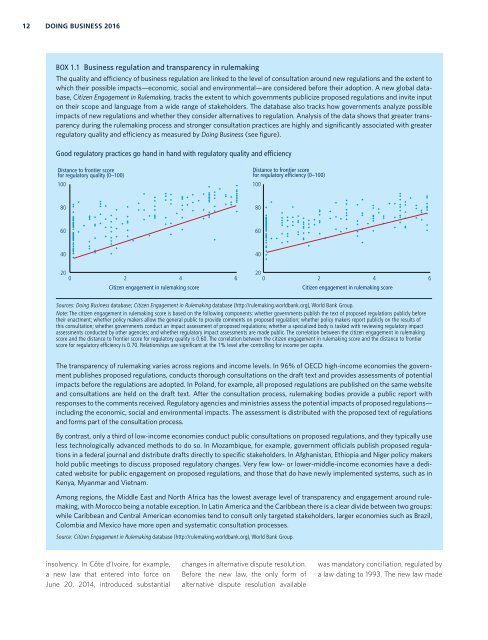Doing Business 2016
1LWKJHK
1LWKJHK
Create successful ePaper yourself
Turn your PDF publications into a flip-book with our unique Google optimized e-Paper software.
12<br />
<strong>Doing</strong> <strong>Business</strong> <strong>2016</strong><br />
BOX 1.1 <strong>Business</strong> regulation and transparency in rulemaking<br />
The quality and efficiency of business regulation are linked to the level of consultation around new regulations and the extent to<br />
which their possible impacts—economic, social and environmental—are considered before their adoption. A new global database,<br />
Citizen Engagement in Rulemaking, tracks the extent to which governments publicize proposed regulations and invite input<br />
on their scope and language from a wide range of stakeholders. The database also tracks how governments analyze possible<br />
impacts of new regulations and whether they consider alternatives to regulation. Analysis of the data shows that greater transparency<br />
during the rulemaking process and stronger consultation practices are highly and significantly associated with greater<br />
regulatory quality and efficiency as measured by <strong>Doing</strong> <strong>Business</strong> (see figure).<br />
Good regulatory practices go hand in hand with regulatory quality and efficiency<br />
Distance to frontier score<br />
for regulatory quality (0–100)<br />
100<br />
Distance to frontier score<br />
for regulatory efficiency (0–100)<br />
100<br />
80<br />
80<br />
60<br />
60<br />
40<br />
40<br />
20<br />
0 2 4 6<br />
Citizen engagement in rulemaking score<br />
20<br />
0 2 4 6<br />
Citizen engagement in rulemaking score<br />
Sources: <strong>Doing</strong> <strong>Business</strong> database; Citizen Engagement in Rulemaking database (http://rulemaking.worldbank.org), World Bank Group.<br />
Note: The citizen engagement in rulemaking score is based on the following components: whether governments publish the text of proposed regulations publicly before<br />
their enactment; whether policy makers allow the general public to provide comments on proposed regulation; whether policy makers report publicly on the results of<br />
this consultation; whether governments conduct an impact assessment of proposed regulations; whether a specialized body is tasked with reviewing regulatory impact<br />
assessments conducted by other agencies; and whether regulatory impact assessments are made public. The correlation between the citizen engagement in rulemaking<br />
score and the distance to frontier score for regulatory quality is 0.60. The correlation between the citizen engagement in rulemaking score and the distance to frontier<br />
score for regulatory efficiency is 0.70. Relationships are significant at the 1% level after controlling for income per capita.<br />
The transparency of rulemaking varies across regions and income levels. In 96% of OECD high-income economies the government<br />
publishes proposed regulations, conducts thorough consultations on the draft text and provides assessments of potential<br />
impacts before the regulations are adopted. In Poland, for example, all proposed regulations are published on the same website<br />
and consultations are held on the draft text. After the consultation process, rulemaking bodies provide a public report with<br />
responses to the comments received. Regulatory agencies and ministries assess the potential impacts of proposed regulations—<br />
including the economic, social and environmental impacts. The assessment is distributed with the proposed text of regulations<br />
and forms part of the consultation process.<br />
By contrast, only a third of low-income economies conduct public consultations on proposed regulations, and they typically use<br />
less technologically advanced methods to do so. In Mozambique, for example, government officials publish proposed regulations<br />
in a federal journal and distribute drafts directly to specific stakeholders. In Afghanistan, Ethiopia and Niger policy makers<br />
hold public meetings to discuss proposed regulatory changes. Very few low- or lower-middle-income economies have a dedicated<br />
website for public engagement on proposed regulations, and those that do have newly implemented systems, such as in<br />
Kenya, Myanmar and Vietnam.<br />
Among regions, the Middle East and North Africa has the lowest average level of transparency and engagement around rulemaking,<br />
with Morocco being a notable exception. In Latin America and the Caribbean there is a clear divide between two groups:<br />
while Caribbean and Central American economies tend to consult only targeted stakeholders, larger economies such as Brazil,<br />
Colombia and Mexico have more open and systematic consultation processes.<br />
Source: Citizen Engagement in Rulemaking database (http://rulemaking.worldbank.org), World Bank Group.<br />
insolvency. In Côte d’Ivoire, for example,<br />
a new law that entered into force on<br />
June 20, 2014, introduced substantial<br />
changes in alternative dispute resolution.<br />
Before the new law, the only form of<br />
alternative dispute resolution available<br />
was mandatory conciliation, regulated by<br />
a law dating to 1993. The new law made


